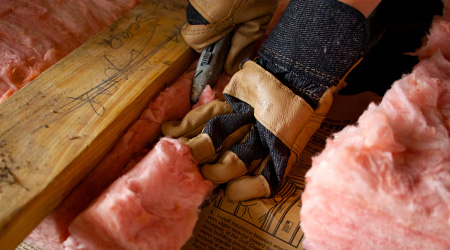7 Cheap Ways to Winterize Your Home

The Environmental Protection Agency estimates that the average household will spend approximately $2,200 on utilities per year with half of that going to heating and cooling. Given that utility bills constitute a significant portion of a household budget, any steps which can be taken to reduce energy usage can free up limited financial resources. Dirty air filters, poor installation and drafty rooms all add up to wasted money for no reason. Listed below are seven of the least expensive ways to help prepare your home for winter and keep heating costs down.
1. Add Roof Insulation
It is recommended to have a minimum of 12 to 16 inches of insulation in the attic to ensure proper R-value. Newer homes often have blown in insulation providing sufficient depth but older homes may have insulation compressed over time leading to less protection. It cost approximately $500 and a few hours of your time to install additional insulation but this could lead to thousands of dollars in reduced heating costs over the life of the home
2. Close off the Attic
Attics with ceiling access, especially those with drop down ladders, are prone to significant heat leakage. If there is no ladder then ensure the panel is properly formed for the opening with a weatherstripping seal around the perimeter. Attic ladders can be covered with an attic tent for a few hundred dollars while a less expensive option is to use foam insulation pads cut to fit the opening.
3. Close Air Leaks
Many homes as they get older will have seals crack and expose the interior to outside airflow and temperature changes which can result in 15% to 35% energy loss. Use a smoke stick or infrared thermometer to test all windows, outlets and light switches to ensure proper sealing to minimize heat loss. Replace weatherstripping around doors as necessary as they wear out over time. Using expanding foam insulation can provide a quick and thorough fix for many air leaks in the home.
4. Seal Air Ducting
Due to heating and cooling changes over time, the seam used the join sections of ducting in an attic can come loose. When the heater is running, hot air can be released through these separations. Replacing duct tape is easy enough to do for most homeowners and HVAC foil tape can be purchased at most hardware supply stores.
5. Change Air Filters
A heating and cooling system is only as efficient as its ability to circulate air. Clogged or dirty air filters can significantly impede airflow resulting in less hot air being thoroughly distributed throughout the home. At a minimum, it is recommended to change air filters seasonally or more often for individuals with allergies and pet owners.
6. Install a Programmable Thermostat
A programmable thermostat can easily save a few hundred dollars a year in heating and cooling costs by being more efficient than manual options. An inexpensive electronic programmable thermostats can be purchased at major retailers and home supply stores for between $40 and $80. These types of thermostats automatically lower the temperature during the day and increase the temperature at night when people are likely to benefit from increased heating of the home.
7. Insulate the Water Heater
The United States Department of Energy estimates that heating water for a home can make up between 14% to 25% of total energy usage. Purchasing and installing a thermal blanket for the hot water heater can cost as little as $25 but prevents unnecessary heat loss especially in a cold garage.
Elsewhere on StockMonkeys.com







